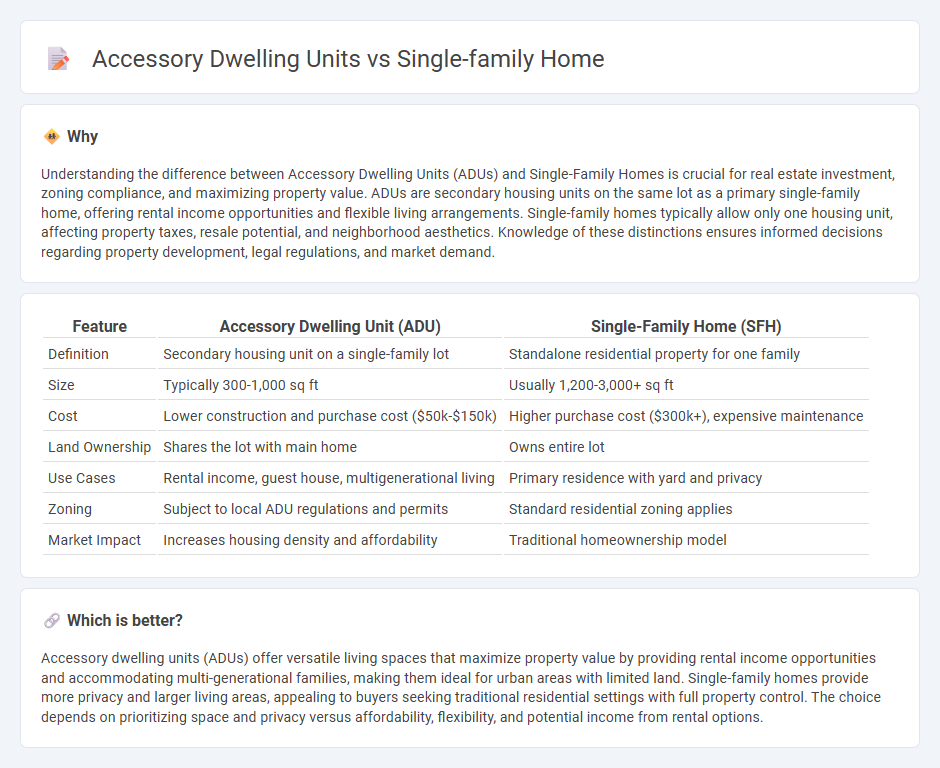
Accessory dwelling units (ADUs) offer flexible living spaces on existing residential lots, often providing affordable housing options and increased property value compared to traditional single-family homes. Single-family homes typically provide larger living areas and more privacy but come with higher purchase and maintenance costs. Explore the benefits and challenges of each housing type to determine the best fit for your real estate needs.
Why it is important
Understanding the difference between Accessory Dwelling Units (ADUs) and Single-Family Homes is crucial for real estate investment, zoning compliance, and maximizing property value. ADUs are secondary housing units on the same lot as a primary single-family home, offering rental income opportunities and flexible living arrangements. Single-family homes typically allow only one housing unit, affecting property taxes, resale potential, and neighborhood aesthetics. Knowledge of these distinctions ensures informed decisions regarding property development, legal regulations, and market demand.
Comparison Table
| Feature | Accessory Dwelling Unit (ADU) | Single-Family Home (SFH) |
|---|---|---|
| Definition | Secondary housing unit on a single-family lot | Standalone residential property for one family |
| Size | Typically 300-1,000 sq ft | Usually 1,200-3,000+ sq ft |
| Cost | Lower construction and purchase cost ($50k-$150k) | Higher purchase cost ($300k+), expensive maintenance |
| Land Ownership | Shares the lot with main home | Owns entire lot |
| Use Cases | Rental income, guest house, multigenerational living | Primary residence with yard and privacy |
| Zoning | Subject to local ADU regulations and permits | Standard residential zoning applies |
| Market Impact | Increases housing density and affordability | Traditional homeownership model |
Which is better?
Accessory dwelling units (ADUs) offer versatile living spaces that maximize property value by providing rental income opportunities and accommodating multi-generational families, making them ideal for urban areas with limited land. Single-family homes provide more privacy and larger living areas, appealing to buyers seeking traditional residential settings with full property control. The choice depends on prioritizing space and privacy versus affordability, flexibility, and potential income from rental options.
Connection
Accessory dwelling units (ADUs) are secondary housing units added to single-family home properties, enhancing residential density without altering neighborhood character. These units maximize land use efficiency and provide homeowners with additional rental income opportunities or flexible living spaces for family members. Integrating ADUs into single-family home lots addresses housing shortages by increasing affordable options within established communities.
Key Terms
Zoning
Single-family homes are typically designated in zoning codes with restrictions on lot size, building height, and setbacks to preserve neighborhood character, often limiting density and housing supply. Accessory dwelling units (ADUs) are increasingly permitted in many zoning ordinances as a strategy to diversify housing options, increase density, and provide affordable living spaces while maintaining single-family neighborhood aesthetics. Explore detailed zoning regulations and their impacts on residential development to understand how these housing types shape urban growth.
Occupancy
Single-family homes typically accommodate one household, promoting privacy and ownership stability, while accessory dwelling units (ADUs) increase occupancy density by providing separate living spaces within the same property. ADUs support diverse household needs, including multi-generational living and rental income opportunities, addressing urban housing shortages. Discover how these housing options impact occupancy trends and urban planning efficiency.
Property value
Single-family homes typically command higher market values due to their larger lot sizes and exclusive use, while accessory dwelling units (ADUs) can enhance overall property value by increasing usable living space and rental income potential. ADUs offer a flexible investment opportunity, often boosting appraisal values by 10-30%, especially in urban areas with high housing demand. Discover how integrating ADUs can maximize your real estate investment portfolio.
Source and External Links
What is a single-family home and is it right for you? - Rocket Mortgage - This article explores the definition of a single-family home, its characteristics, and whether it's suitable for potential buyers.
What Is A Single-Family Home? | Bankrate - This page defines a single-family home as a standalone residential structure designed for one household, discussing its pros and cons.
Single-family detached home - Wikipedia - This article provides information about single-family detached homes, including their common characteristics and global distribution.
 dowidth.com
dowidth.com